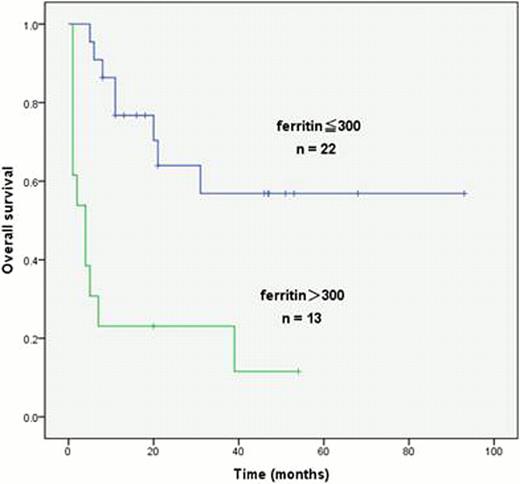Abstract
Abstract 2644
Extranodal NK/T-cell lymphoma, nasal type (ENKL) is a rare subtype in Western countries but is more frequent in East Asia or in Central and South America. The response to conventional chemotherapy is not good, generally resulting in a poor prognosis. Several Asian investigators reported that the International Prognostic Index (IPI) score, Prognostic Index for PTCL-U (PIT) and Korean index, including regional lymph node involvement, clinical stage, presence of B symptom and serum lactate dehydrogenase (LDH) levels, are good indicators for prognosis. We retrospectively analyzed the prognostic factors of our patients with ENKL.
A total of forty-two patients were diagnosed as having ENKL from April 1998 to May 2011 at Yokohama City University Hematology Group, consisting of eight hospitals in Japan. Central pathological review was not performed; only the individual institutional diagnoses were used. Overall survival (OS) was measured from the date of diagnosis to the date of death or the last follow-up. This study was approved by the Yokohama City University Hospital Clinical Research Ethics Board. The procedures used in this study were in accordance with the Helsinki Declaration.
The study included 27 males and 15 females, with the median age at diagnosis of 63 years (range, 18–82 years). Twenty-five patients had localized while 17 patients had advanced Ann Arbor stages of lymphoma. Thirty-two patients had a good ECOG performance status of 0–1. B symptoms were present in 18 patients. Thirty patients presented with nasal and/or paranasal lesions. Twelve patients showed no nasal/paranasal involvement. Of these patients, seven (7/12) had skin involvement, and one each (1/12) with involvement of the gingiva, liver, intestines, testis and lymph node, respectively. According to IPI, 17 patients were classified as low, 9 as low-intermediate, 6 as high-intermediate (HI), and 10 as high (H) risk. According to PIT, 10 patients were categorized as group 1, 16 as group 2, 10 as group 3, and 6 as group 4. According to the Korean index, 11 patients were classified as group 1, 9 as group 2, 10 as group 3, and 12 as group 4. Combined radiotherapy-chemotherapy was administered to 23 patients, 11 patients were treated with chemotherapy alone, 6 patients received radiotherapy alone, and two could not be treated due to their poor condition. After a median follow-up duration among all patients of 12 months (range 1–93 months), and a median follow-up duration among patients still alive at their last follow-up of 47 months (range 8–93 months), 3-year OS rate was 46.7%. Factors associated with a worse overall survival in a univariate analysis were IPI score of HI or H (p<0.001), PIT group 3 or 4 (p=0.002), Korean index group 3 or 4 (p=0.003), extranasal disease (p=0.01), advanced Ann Arbor stage (stage III or IV, p<0.001), ferritin levels higher than 300 ng/ml (p=0.001), B symptoms (p=0.001), albumin levels less than 4 g/dl (p=0.003), LDH value at normal levels or above (p=0.005), soluble IL2R levels higher than 650 U/ml (p=0.006) and β2 microglobulin levels higher than 2.5 mg/l (p=0.035). Multivariate analysis revealed three factors: advanced stage (III or IV) (HR 8.994; 95%CI, 2.188–36.963, p=0.002), extranasal disease (HR 4.824; 95%CI, 1.400–16.624, p=0.013), and high ferritin levels (HR 18.767; 95%CI, 4.207–83.724, p<0.001), to be significant and independent prognostic factors.
Advanced stage, extranasal ENKL, and high ferritin levels were associated with an adverse outcome for patients with ENKL. The former two were demonstrated as prognostic factors in previous reports. As far as we are concerned, this is first report showing ferritin levels as a prognostic factor. This result should be confirmed in a large number of cases.
No relevant conflicts of interest to declare.
Author notes
Asterisk with author names denotes non-ASH members.


This feature is available to Subscribers Only
Sign In or Create an Account Close Modal